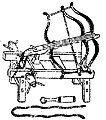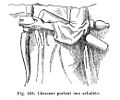Crossbow

Acrossbowis aranged weaponusing anelasticlaunching device consisting of abow-like assembly called aprod,mounted horizontally on a main frame called atiller,which is hand-held in a similar fashion to thestockof along gun.Crossbows shootarrow-likeprojectilescalledboltsorquarrels.A person who shoots crossbow is called acrossbowman,anarbalisteror anarbalist(after thearbalest,a European crossbow variant used during the 12th century).[1]
Crossbows and bows use the same elastic launch principles, but differ in that an archer using abowmust draw-and-shoot in a quick and smooth motion with limited or no time for aiming, while a crossbow's design allows it to be spanned and cocked ready for use at a later time and thus affording them unlimited time to aim. When shooting bows, the archer must fully perform thedraw,holding the string and arrow using various techniques while pulling it back with arm and back muscles, and then either immediately shooting instinctively without a period of aiming, or holding thatformwhile aiming. Both demand somephysical strengthto do so using bows suitable for warfare, though this is easier using lighterdraw-weighthunting bows. As such, their accurate and sustained use in warfare takes a lot of practice.
Crossbows avoid these potential problems by having trigger-released cocking mechanisms to maintain the tension on the string once it has beenspanned- drawn - into its ready-to-shoot position, allowing these weapons to be carried cocked and ready and affording their users time to aim them. This also allows them to be readied by someone assisting their users, so multiple crossbows can be used one after the other while others reload and ready them. Crossbows are spanned into their cocked positions using a number of techniques and devices, some of which are mechanical and employ gear and pulley arrangements - levers, belt hooks, pulleys, windlasses and cranequins - to overcome very high draw weight.[2]These potentially achieve better precision and enable their effective use by less-familiarised and trained personnel, whereas the simple and composite warbows of, for example, the English and the steppe nomads require years of training, practice and familiarisation.
These advantages for the crossbow are somewhat offset by the longer time needed to reload a crossbow for further shots, with the crossbows with high draw weights requiring sophisticated systems of gears and pulleys to overcome their huge draw weights that are very slow and rather awkward to employ on the battlefield. Medieval crossbows were also very inefficient, with short shot stroke lengths from the string lock to the release point of their bolts, along with the slower speeds of their steel prods and heavy strings, despite their massive draw weights compared to bows, though modern materials and crossbow designs overcome these shortcomings.
When trying to compare these weapons in their historic contexts, a rough idea of which weapon system was most effective can be found with a quick glimpse the successes of their historical use. This shows that the composite bow systems of the various steppe nomads and their imitators were successfully employed as primary weapons systems to conquer far more territory over a much longer period of time than both the simple bow system of the English longbow and any sort of crossbow system at any time, anywhere.[citation needed]
The earliest known crossbows were made in the first millennium BC, as early as the 7th century BC inancient Chinaand as early as the 1st century AD in Greece (as thegastraphetes).[3][4]Crossbows brought about a major shift in the role ofprojectile weaponryin wars, such as duringQin's unification warsand laterHan campaigns against northern nomadsandwestern states.The medieval European crossbow was called by many names, including "crossbow" itself; most of these names derived from the wordballista,anancient Greektorsionsiege enginesimilar in appearance but different in design principle.[5]
In modern times,firearmshave largely supplanted bows and crossbows as weapons of war, but crossbows remain widely used for competitiveshooting sportsand hunting, and for relatively silent shooting.[6]
Terminology
[edit]A crossbowman is sometimes called anarbalist,or historically anarbalister.
Arrow,boltandquarrelare all suitable terms[1]for crossbow projectiles, as wasvirehistorically.
Thelath,also called theprod,is the bow of the crossbow. According to W.F. Peterson, theprodcame into usage in the 19th century as a result of mistranslatingroddin a 16th-century list of crossbow effects.[1]
Thestockis the wooden body on which the bow is mounted, although the medievaltilleris also used.[1]
Thelockrefers to the release mechanism, including the string, sears, trigger lever, and housing.[1]
Construction
[edit]

- Nut.
- String.
- Quarrel.
- Trigger.

A crossbow is essentially abowmounted on an elongated frame (called a tiller or stock) with a built-in mechanism that holds the drawnbow string,as well as atriggermechanism, which is used to release the string.
Chinese vertical trigger lock
[edit]The Chinese trigger was a mechanism typically composed of threecastbronzepieces housed inside a hollow bronzeenclosure.The entire mechanism is then dropped into a carved slot within the tiller and secured together by two bronzerods.[1]The string catch (nut) is shaped like a "J" because it usually has a tall erect rear spine that protrudes above the housing, which serves the function of both a cocking lever (by pushing the drawn string onto it) and a primitive rear sight. It is held stationary against tension by the second piece, which is shaped like a flattened "C" and acts as thesear.The sear cannot move as it is trapped by the third piece, i.e. the actual trigger blade, which hangs vertically below the enclosure and catches the sear via a notch. The twobearing surfacesbetween the three trigger pieces each offers amechanical advantage,which allow for handling significant draw weights with a much smaller pull weight. During shooting, the user will hold the crossbow at eye level by avertical handleand aim along the arrow using the sighting spine forelevation,similar to how a modernriflemanshoots withiron sights.When the trigger blade is pulled, its notch disengages from the sear and allows the latter to drop downwards, which in turn frees up the nuts to pivot forward and release the bowstring.
Thenu( nỗ ) [crossbow] is so called because it spreads abroad an aura of rage [nù] ( nộ ). Its stock is like the arm of a man, therefore it is calledbi( tí ). That which hooks the bowstring is calledya( nha ), for indeed it is like teeth. The part round about the teeth [i.e. the housing box] is called theguo( quách ) [ "city wall" ], since it surrounds thegui( quy ) [lug] of the teeth [i.e. the locking nut]. Within [and below] there is thexuan dao( huyền đao ) [ "hanging knife", i.e. the trigger blade] so called because it looks like one. The whole assembly is calledji( cơ )[ "machine" or "mechanism" ], for it is just as ingenious as theloom.[7]
— Shiming
European rolling nut lock
[edit]The earliest European designs featured a transverse slot in the top surface of the frame, down into which the string was placed. To shoot this design, a vertical rod is thrust up through a hole in the bottom of the notch, forcing the string out. This rod is usually attached perpendicular to a rear-facing lever called atickler.A later design implemented a rolling cylindrical pawl called anutto retain the string. This nut has a perpendicular centre slot for the bolt, and an intersecting axial slot for the string, along with a lower face or slot against which the internal trigger sits. They often also have some form of strengthening internalsearor trigger face, usually of metal. Theseroller nutswere either free-floating in their close-fitting hole across the stock, tied in with a binding of sinew or other strong cording; or mounted on a metal axle or pins. Removable or integral plates of wood, ivory, or metal on the sides of the stock kept the nut in place laterally. Nuts were made of antler, bone, or metal. Bows could be kept taut and ready to shoot for some time with little physical straining, allowing crossbowmen to aim better without fatiguing.
Bow
[edit]Chinese crossbow bows were made of composite material from the start.[1]
European crossbows from the 10th to 12th centuries used wood for the bow, also called theprodorlath,which tended to beashoryew.[1]
Composite bows started appearing in Europe during the 13th century and could be made from layers of different material, often wood, horn, and sinew glued together and bound with animal tendon. These composite bows made of several layers are much stronger and more efficient in releasing energy than simple wooden bows.[1]
As steel became more widely available in Europe around the 14th century, steel prods came into use.[1]
Traditionally, the prod was often lashed to the stock with rope,whipcord,or other strong cording. This is called thebridle[1]
Spanning mechanism
[edit]The Chinese usedwinchesfor large crossbows mounted onfortificationsorwagons,known as "bedded crossbows" ( sàng nỗ ). Winches may have been used for handheld crossbows during theHan dynasty(202 BC–9 AD, 25–220 AD), but there is only one known depiction of it. The 11th century Chinese military textWujing Zongyaomentions types of crossbows using winch mechanisms, but it is not known if these were actually handheld crossbows or mounted crossbows.[8]Another drawing method involved the shooters sitting on the ground, and using the combined strength of leg, waist, back and arm muscles to help span much heavier crossbows, which were aptly called "waist-spun crossbows" ( yêu trương nỗ ).
During themedieval era,both Chinese and European crossbows usedstirrupsas well asbelt hooks.[8]In the 13th century, European crossbows started using winches, and from the 14th century an assortment of spanning mechanisms such as winch pulleys, cord pulleys, gaffles (such as gaffe levers, goat's foot levers, and rarer internal lever-action mechanisms), cranequins, and even screws.[1][9]
-
Battle scene depicting a man spanning a crossbow using a winch mechanism, possibly mounted on a frame,Han dynasty
-
Song dynastycavalry wielding crossbows with stirrups
-
Fifteenth century crossbowman using a stirrup along with a belt hook and pulley
-
Detailed illustration of a goat's foot lever mounted on a crossbow that is half-spanned
-
Illustration of a gaffe lever mounted on a crossbow that is nearly at full-span.
-
Illustrations of Leonardo da Vinci'srapid fire crossbowin the 15th-centuryCodex Atlanticus.Note the internal lever mechanism is fully extended to catch the draw string.
-
Internal mechanics illustration of a Balester hunting crossbow's self-spanning mechanism
-
Twentieth century depiction of awindlasspulley
-
Fifteenth century crossbowman using a cranequin (rack & pinion)
-
Iron cranequin, South German, late 15th century
Variants
[edit]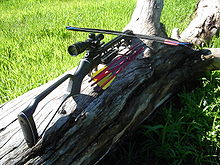

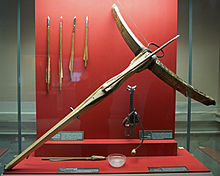
The smallest crossbows are pistol crossbows. Others are simple long stocks with the crossbow mounted on them. These could be shot from under the arm. The next step in development was stocks of the shape that would later be usedfor firearms,which allowed better aiming. Thearbalestwas a heavy crossbow that required special systems for pulling the sinew via windlasses. Forsiege warfare,the size of crossbows was further increased to hurl large projectiles, such as rocks, at fortifications. The required crossbows needed a massive base frame and powerful windlass devices.[10]
-
Double shot repeating crossbow, also known as the Chu staterepeating crossbow(chuguo nu)
-
Mounted double bow crossbow
-
Mounted triple bow crossbow
-
Multi-bolt crossbow without a visible nut or cocking aid
-
Cocking of a Greekgastraphetes
-
Gallo-Roman crossbow
-
Earliest European depiction of cavalry using crossbows, from theCatalanmanuscriptFour Horsemen of the Apocalypse,1086.
-
Late medievalcrossbowman from ca. 1480
-
A reconstruction of Leonardo da Vinci's rapid fire crossbow as shown at the World of Leonardo Exhibition in Milan.
-
Early modern four-wheeledballistadrawn by armored horses (1552)
-
16th-century French mounted crossbowman (cranequinier). His crossbow is drawn with a rack-and-pinioncranequin,so it can be used while riding.
-
Pistol crossbow for home recreational shooting. Made by Frédéric Siber inMorges,early 19th century, on display at Morges military museum.
-
French cross-bow grenade thrower Arbalète sauterelle type A d'Imphy, circa 1915
Projectiles
[edit]
The arrow-like projectiles of a crossbow are calledbolts or quarrels.These are usually much shorter than arrows but can be several times heavier. There is an optimum weight for bolts to achieve maximum kinetic energy, which varies depending on the strength and characteristics of the crossbow, but most could pass through common mail. Crossbow bolts can be fitted with a variety of heads, some with sickle-shaped heads to cut rope or rigging; but the most common today is a four-sided point called aquarrel.A highly specialized type of bolt is employed to collect blubber biopsy samples used in biology research.
Even relatively small differences in arrow weight can have a considerable impact on its flight trajectory and drop.[11]
Bullet-shooting crossbowsare modified crossbows that use bullets or stones as projectiles.
Accessories
[edit]
Theancient Chinesecrossbow often included a metal (i.e. bronze or steel) grid serving asiron sights.Modern crossbow sights often use similar technology to modern firearm sights, such asred dot sightsandtelescopic sights.Many crossbow scopes feature multiplecrosshairsto compensate for the significant effects ofgravityover different ranges. In most cases, a newly bought crossbow will need to be sighted for accurate shooting.[12]
A major cause of the sound of shooting a crossbow is vibration of various components. Crossbow silencers are multiple components placed on high vibration parts, such as the string and limbs, to dampen vibration and suppress the sound of loosing the bolt.[13]
History
[edit]China
[edit]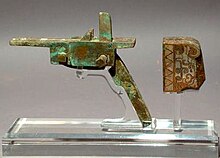

In terms of archaeological evidence, crossbow locks made ofcast bronzehave been found in China dating to around 650 BC.[1]They have also been found in Tombs 3 and 12 atQufu,Shandong,previously the capital ofLu,and date to the 6th century BC.[14]Bronze crossbow bolts dating from the mid-5th century BC have been found at aChuburial site in Yutaishan,Jiangling County,HubeiProvince.[15]Other early finds of crossbows were discovered in Tomb 138 at Saobatang,HunanProvince, and date to the mid-4th century BC.[16][17]It is possible that these early crossbows usedspherical pelletsfor ammunition. AWestern Hanmathematician and music theorist,Jing Fang(78–37 BC), compared the moon to the shape of a roundcrossbow bullet.[18]TheZhuangzialso mentions crossbow bullets.[19]
The earliest Chinese documents mentioning a crossbow were texts from the 4th to 3rd centuries BC attributed to thefollowersofMozi.This source refers to the use of a giant crossbow between the 6th and 5th centuries BC, corresponding to the lateSpring and Autumn period.Sun Tzu'sThe Art of War(first appearance dated between 500 BC to 300 BC[20]) refers to the characteristics and use of crossbows in chapters 5 and 12 respectively,[21]and compares a drawn crossbow to "might".[22]TheHuainanziadvises its readers not to use crossbows in marshland where the surface is soft and it is hard to arm the crossbow with the foot.[23]TheRecords of the Grand Historian,completed in 94 BC, mentions thatSun BindefeatedPang Juanby ambushing him with a battalion of crossbowmen at theBattle of Malingin 342 BC.[24]TheBook of Han,finished 111 AD, lists two military treatises on crossbows.[25][26]
Handheld crossbows with complex bronze trigger mechanisms have also been found with theTerracotta Armyin the tomb ofQin Shi Huang(r. 221–210 BC) that are similar to specimens from the subsequentHan dynasty(202 BC–220 AD), while crossbowmen described in the Qin and Han dynasty learned drill formations, some were even mounted ascharioteersandcavalry units,and Han dynasty writers attributed the success of numerousbattles against the XiongnuandWestern Regionscity-statesto massed crossbow volleys.[27]The bronze triggers were designed in such a way that they were able to store a large amount of energy within the bow when drawn but was easily shot with little resistance and recoil when the trigger was pulled. The trigger nut also had a long vertical spine that could be used like a primitiverear sightforelevationadjustment, which allowed precision shooting over longer distances. The Qin and Han dynasty-era crossbow was also an early example of amodular design,as the bronze trigger components were also mass-produced with relative precisetolerancesso that the parts were interchangeable between different crossbows. The trigger mechanism from one crossbow can be installed into another simply by dropping into a tiller slot of the same specifications and secured withdowel pins.Some crossbow designs were also found to be fitted with bronze buttplates andtrigger guard.
It is clear from surviving inventory lists inGansuandXinjiangthat the crossbow was greatly favored by the Han dynasty. For example, in one batch of slips there are only two mentions of bows, but thirty mentions of crossbows.[23]Crossbows were mass-produced in state armories with designs improving as time went on, such as the use of a mulberry wood stock and brass. Such crossbows during theSong Dynastyin 1068 AD could pierce a tree at 140 paces.[28]Crossbows were used in numbers as large as 50,000 starting from the Qin dynasty and upwards of several hundred thousand during the Han.[29]According to one authority, the crossbow had become "nothing less than the standard weapon of the Han armies", by the second century BC.[30]Han soldiers were required to arm a crossbow with a draw weight equivalent of 76 kg (168 lb) to qualify as an entry-level crossbowman,[1]while it was claimed that a few elite troops were capable of arming crossbows with a draw-weight in excess of 340 kg (750 lb) by the hands-and-feet method.[31][32]
After the Han dynasty, the crossbow lost favor during theSix Dynasties,until it experienced a mild resurgence during theTang dynasty,under which the ideal expeditionary army of 20,000 included 2,200 archers and 2,000 crossbowmen.[33]Li Jingand Li Quan prescribed 20 percent of the infantry to be armed with crossbows.[34]
During theSong dynasty,the crossbow received a huge upsurge in military usage, and often overshadowed the bow 2 to 1 in numbers. During this time period, astirrupwas added for ease of loading. The Song government attempted to restrict the public use of crossbows and sought ways to keep bothbody armorand crossbows out of civilian ownership.[35]Despite the ban on certain types of crossbows, the weapon experienced an upsurge in civilian usage as both a hunting weapon and pastime. The "romantic young people from rich families, and others who had nothing particular to do" formed crossbow-shooting clubs as a way to pass time.[36]
During the lateMing dynasty,no crossbows were mentioned to have been produced in the three-year period from 1619 to 1622. With 21,188,366 taels, the Ming manufactured 25,134 cannons, 8,252 small guns, 6,425 muskets, 4,090 culverins, 98,547 polearms and swords, 26,214 great "horse decapitator" swords, 42,800 bows, 1,000 great axes, 2,284,000 arrows, 180,000 fire arrows, 64,000 bow strings, and hundreds of transport carts.[37]
Military crossbows were armed by treading, or basically placing the feet on the bow stave and drawing it using one's arms and back muscles. During the Song dynasty, stirrups were added for ease of drawing and to mitigate damage to the bow. Alternatively, the bow could also be drawn by a belt claw attached to the waist, but this was done lying down, as was the case for all large crossbows. Winch-drawing was used for the large mounted crossbows as seen below, but evidence for its use in Chinese hand-crossbows is scant.[8]
There were also other sorts of crossbows, such as therepeating crossbow,multi-shot crossbow, and larger field artillery crossbows.
Southeast Asia
[edit]
Around the third century BC,King An DươngofÂu Lạc(modern-daynorthern Vietnam) and (modern-daysouthern China) commissioned a man namedCao Lỗ(or Cao Thông) to construct a crossbow and christened it "Saintly Crossbow of the Supernaturally Luminous Golden Claw"(nỏ thần),which could kill 300 men in one shot.[38][39]According to historian Keith Taylor, the crossbow, along with the word for it, seems to have been introduced into China fromAustroasiaticpeoples in the south around the fourth century BC.[39]However, this is contradicted by crossbow locks found in ancient ChineseZhou dynastytombs dating to the 600s BC.[1]
In 315 AD, Nu Wen taught theChamshow to build fortifications and use crossbows. The Chams would later give the Chinese crossbows as presents on at least one occasion.[35]
Crossbow technology for crossbows with more than one prod was transferred from the Chinese toChampa,which Champa used in its invasion of theKhmer Empire'sAngkorin 1177.[40]When the Chams sacked Angkor they used the Chinese siege crossbow.[41][42]The Chinese taught the Chams how to use crossbows and mounted archery Crossbows and archery in 1171.[43]The Khmer also had double-bow crossbows mounted on elephants, which Michel Jacq-Hergoualc'h suggests were elements of Cham mercenaries inJayavarman VII's army.[44]
The nativeMontagnardsof Vietnam's Central Highlands were also known to have used crossbows, as both a tool for hunting, and later an effective weapon against theViet Congduring the Vietnam War.[45]Montagnard fighters armed with crossbows proved a highly valuable asset to the US Special Forces operating in Vietnam, and it was not uncommon for the Green Berets to integrate Montagnard crossbowmen into their strike teams.[46]
Ancient Greece
[edit]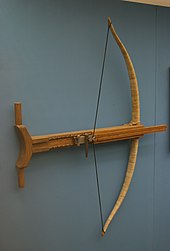
The earliest crossbow-like weapons in Europe probably emerged around the late 5th century BC when thegastraphetes,an ancient Greek crossbow, appeared. The name means "belly-bow";[47]the concave withdrawal rest at one end of the stock was placed against the belly of the operator, and he could press it to withdraw the slider before attaching a string to the trigger and loading the bolt; this could store more energy thanGreek bows.[48]The device was described by the Greek authorHeron of Alexandriain hisBelopoeica( "On Catapult-making" ), which draws on an earlier account of his compatriot engineerCtesibius(fl.285–222 BC). According to Heron, thegastrapheteswas the forerunner of the latercatapult,which places its invention some unknown time prior to 399 BC.[49]Thegastrapheteswas a crossbow mounted on a stock divided into a lower and upper section. The lower was a case fixed to the bow, and the upper was a slider which had the same dimensions as the case.[47]It was used in theSiege of Motyain 397 BC. This was a keyCarthaginianstronghold inSicily,as described in the 1st century AD byHeron of Alexandriain his bookBelopoeica.[50]
There were also other arrow-shooting machines such as the largerballistaand smallerScorpiofrom around 338 BC, but these aretorsioncatapultsand are not considered crossbows.[51][52][53]Arrow-shooting machines (katapeltai) are briefly mentioned byAeneas Tacticusin his treatise on siegecraft written around 350 BC.[51]An Athenian inventory from 330 to 329 BC includes catapults bolts with heads and flights.[53]Arrow-shooting machines in action are reported fromPhilip II'ssiege ofPerinthosinThracein 340 BC.[54]At the same time, Greek fortifications began to feature high towers with shuttered windows in the top, presumably to house anti-personnel arrow shooters, as inAigosthena.[55]
Ancient Rome
[edit]
The late 4th century authorVegetius,in hisDe Re Militari,describesarcubalistarii(crossbowmen) working together with archers and artillerymen.[1]However it is disputed whether arcuballistas were crossbows or torsion-powered weapons. The idea that the arcuballista was a crossbow is due to Vegetius referring separately to it and themanuballista,which was torsion powered. Therefore, if the arcuballista was not like the manuballista, it may have been a crossbow. According to Vegetius these were well-known devices and hence he did not describe them in depth. Joseph Needham argues against the existence of Roman crossbowmen:[56]
On the textual side, there is almost nothing but passing references in the military historian Vegetius (fl. + 386) to 'manuballistae' and 'arcuballistae' which he said he must decline to describe as they were so well known. His decision was highly regrettable, as no other author of the time makes any mention of them at all. Perhaps the best supposition is that the crossbow was primarily known in late European antiquity as a hunting weapon, and received only local use in certain units of the armies of Theodosius I, with which Vegetius happened to be acquainted.[56]
— Joseph Needham
On the other handArrian's earlierArs Tactica,from about 136 AD, also mentions 'missiles shot not from a bow but from a machine' and that this machine was used on horseback while in full gallop. It is presumed that this was a crossbow.[1]
The only pictorial evidence of Roman arcuballistas comes from sculptural reliefs inRoman Gauldepicting them in hunting scenes. These are aesthetically similar to both the Greek and Chinese crossbow but it is not clear what kind of release mechanism they used. Archaeological evidence suggests they were similar to the rolling nut mechanism of medieval Europe.[1]
Medieval Europe
[edit]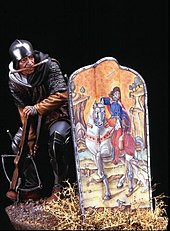
There are essentially no references to the crossbow in Europe from the 5th until the 10th century. There is however a depiction of a crossbow as a hunting weapon on fourPictish stonesfromearly medieval Scotland(6th to 9th centuries):St. Vigeans no. 1,Glenferness,Shandwick,andMeigle.[57]
The crossbow reappeared again in 947 as a French weapon during the siege ofSenlisand again in 984 at the siege ofVerdun.[58]Crossbows were used at thebattle of Hastingsin 1066, and by the 12th century they had become common battlefield weapons.[59]The earliest extant European crossbow remains were found atLake Paladru,dated to the 11th century.[1]
The crossbow superseded hand bows in many European armies during the 12th century, except in England, where thelongbowwas more popular. Later crossbows (sometimes referred to asarbalests), utilizing all-steel prods, were able to achieve power close (and sometime superior) to longbows but were more expensive to produce and slower to reload because they required the aid of mechanical devices such as the cranequin orwindlassto draw back their extremely heavy bows. Usually these could shoot only two bolts per minute versus twelve or more with a skilled archer, often necessitating the use of apavise(shield) to protect the operator from enemy fire.[60]Along withpolearmweapons made from farming equipment, the crossbow was also a weapon of choice for insurgent peasants such as theTaborites.Genoese crossbowmenwere famous mercenaries hired throughout medieval Europe, whilst the crossbow also played an important role in anti-personnel defense of ships.[61]
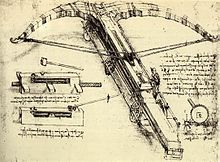
Crossbows were eventually replaced in warfare bygunpowderweapons. Earlyhand cannonshad slower rates of fire and much worse accuracy than contemporary crossbows, but thearquebus(which proliferated in the mid to late 15th century) matched crossbows' rate of fire while being far more powerful. TheBattle of Cerignolain 1503 was won by Spain largely through the use of matchlock arquebuses, marking the first time a major battle had been won through the use of hand-held firearms. Later, similar competing tactics would featureharquebusiersormusketeersin formation with pikemen, pitted against cavalry firingpistolsorcarbines.While the military crossbow had largely been supplanted by firearms on the battlefield by 1525, the sporting crossbow in various forms remained a popular hunting weapon in Europe until the eighteenth century.[62]Crossbows saw irregular use throughout the rest of the 16th century; for example,Maria Pita's husband was killed by a crossbowman of theEnglish Armadain 1589.
Islamic world
[edit]There are no references to crossbows inIslamictexts earlier than the 14th century.Arabsin general were averse to the crossbow and considered it a foreign weapon. They called itqaus al-rijl(foot-drawn bow),qaus al-zanbūrak(bolt bow) andqaus al-faranjīyah(Frankish bow). AlthoughMuslimsdid have crossbows, there seems to be a split between eastern and western types. Muslims in Spain used the typical European trigger, while eastern Muslim crossbows had a more complex trigger mechanism.[63]
Mamlukcavalry used crossbows.[1]
Elsewhere and later
[edit]Oyumiwere ancient Japaneseartillery piecesthat first appeared in the seventh century (during theAsuka period).[64]According to Japanese records, the Oyumi was different from the handheld crossbow also in use during the same time period. A quote from a seventh-century source seems to suggest that the Oyumi may have able to fire multiple arrows at once: "the Oyumi were lined up and fired at random, the arrows fell like rain".[64]A ninth-century Japanese artisan named Shimaki no Fubito claimed to have improved on a version of the weapon used by the Chinese; his version could rotate and fire projectiles in multiple directions.[65][66]The last recorded use of the Oyumi was in 1189.[64]
InWestandCentral Africa,[67]crossbows served as a scouting weapon and for hunting, with African slaves bringing this technology to natives in America.[68]In theSouthern United States,the crossbow was used for hunting and warfare when firearms or gunpowder were unavailable because of economic hardships or isolation.[68]In the north of Northern America, light hunting crossbows were traditionally used by theInuit.[69][non-tertiary source needed]These are technologically similar to the African-derived crossbows, but have a different route of influence.
Spanishconquistadorscontinued to use crossbows in the Americas long after they were replaced in European battlefields by firearms. Only in the 1570s, did firearms become completely dominant among the Spanish in the Americas.[70]
TheFrenchand theBritishused a crossbow-likeSauterelle(French forgrasshopper) inWorld War I.It was lighter and more portable than theLeach Trench Catapult,but less powerful. It weighed 24 kg (53 lb) and could throw anF1 grenadeorMills bomb110–140 m (120–150 yd).[71]The Sauterelle replaced the Leach Catapult in British service and was in turn replaced in 1916 by the2-inch Medium Trench MortarandStokes mortar.[72]Early in the war actual crossbows were pressed into service in small numbers by both French and German troops to launch grenades.[73]
A range of crossbows were developed by theAllied powersduring theSecond World Warforassassinationsandcovert operations,but none appear to have ever been used in the field.[74]A small number of crossbows were built and used by Australian forces in theNew Guinea campaign.[74]
Modern use
[edit]
Hunting, leisure, and science
[edit]Crossbows are used forshooting sportsand bowhunting in modernarcheryand forblubberbiopsysamples in scientific research. Insome countriessuch as Canada, they may be less heavily regulated than firearms, and thus more popular for hunting; some jurisdictions have bow and/or crossbow only seasons.[75]
-
Modern hunting crossbow
-
Fisheries scientist obtaining tissue samples from dolphins swimming in the bow wave of aNOAAship
Military and paramilitary
[edit]Crossbows are no longer used in battles, but they are still used in some military applications. For example, there is an undated photograph ofPeruvian soldiersequipped with crossbows and rope to establish azip-linein difficult terrain.[76]In Brazil, the CIGS (Jungle Warfare Training Center) also trains soldiers in the use of crossbows.[77]
In the United States, SAA International Ltd manufacture a 200 J (150 ft⋅lbf) crossbow-launched version of the U.S. Army type classified LaunchedGrapnel Hook(LGH), among other mine countermeasure solutions designed for the Middle Eastern theatre. It was evaluated as successful inCambodiaandBosnia.[78]It is used to probe for and detonate tripwire-initiated mines and booby traps at up to 50 m (55 yd). The concept is similar to the LGH device originally fired from a rifle, as a plastic retrieval line is attached.[79]Reusable up to 20 times, the line can be reeled back in without exposing the user. The device is of particular use in tactical situations where noise discipline is important.[80]
In Europe, Barnett International sold crossbows toSerbian forceswhich, according toThe Guardian,were later used "inambushesand as a counter-sniper weapon "against theKosovo Liberation Armyduring theKosovo Warin the areas ofPecandDjakovica,south west of Kosovo.[81]Whitehalllaunched an investigation, though theDepartment of Trade and Industryestablished that not being "on the military list", crossbows were not covered by export restrictions. Paul Beaver of Jane's Defence Publications commented that, "They are not only a silent killer, they also have a psychological effect". On 15 February 2008, Serbian Minister of DefenceDragan Sutanovacwas pictured testing a Barnett crossbow during a public exercise of theSerbian Army's Special Forces inNis,200 km (120 mi) south ofBelgrade.[82]Special forces in both Greece and Turkey also continue to employ the crossbow.[83][84]Spain's Green Berets still use the crossbow as well.[85]
In Asia, some Chinese armed forces use crossbows, including thespecial forceSnow Leopard Commando Unitof thePeople's Armed Policeand thePeople's Liberation Army.One reason for this is the crossbow's ability to stop persons carrying explosives without risk of causing detonation.[86]During theXinjiang riots of July 2009,Crossbows were used by security forces to suppress rioters.[87]TheIndian Navy'sMarine Commando Forcewere equipped until the late 1980s with crossbows withcyanide-tipped bolts, as an alternative tosuppressed handguns.[88]
Comparison to conventional bows
[edit]With a crossbow, archers could release a draw force far in excess of what they could have handled with a bow. Furthermore, the crossbow could hold the tension indefinitely, whereas even the strongest longbowman could only hold a drawn bow for a short time. The ease of use of a crossbow allows it to be used effectively with little training, while other types of bows take far more skill to shoot accurately.[89]The disadvantage is the greater weight and clumsiness to reload compared to a bow, as well as the slower rate of shooting and the lower efficiency of the acceleration system, but there would be reducedelastic hysteresis,making the crossbow a more accurate weapon.
Medieval European crossbows had a much smaller draw length than bows, so that for the same energy to be imparted to the projectile the crossbow had to have a much higher draw weight.
A direct comparison between a fast hand-drawn replica crossbow and a longbow shows a 6:10 rate of shooting[90]or a 4:9 rate within 30 seconds and comparable weapons.[91]
Legislation
[edit]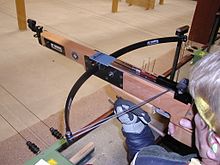
Today, the crossbow often has a complicated legal status due to the possibility of lethal use and its similarities to both firearms and bows. While some jurisdictions treat crossbows in the same way as firearms, many others do not require any sort of license to own a crossbow. The legality of using a crossbow for hunting varies widely in different jurisdictions.
See also
[edit]References
[edit]Citations
[edit]- ^abcdefghijklmnopqrstLoades 2018.
- ^"Crossbows - Spanning Methods".todsworkshop.com.
- ^Tom Ukinski (23 May 2013)."Drones: Mankind's Always Had Them".Guardian Liberty Voice.Retrieved1 March2015.
- ^Shoup, Kate (2016).The Technology of Ancient Greece.Cavendish Square Publishing, LLC. p. 47.ISBN978-1502622310.Archivedfrom the original on 26 November 2022.Retrieved3 October2022.
- ^Payne-Gallwey, Ralph(2007) [1903],The Crossbow,Skyhorse Publishing Inc., p. 2,ISBN978-1602390102
- ^"The Rise of the Modern Crossbow".Digital.outdooenebraska.gov.
- ^Needham 1994,p. 133.
- ^abcNeedham 1994,p. 150.
- ^Ixax, belle."Crossbow Reviews 2017".Archer's Café.Retrieved9 March2017.
- ^O'Connell, Robert L (1989).Of Arms and Men: A History of War, Weapons, and Aggression.Oxford University Press.p.65.ISBN0195053591.
- ^"Crossbow Arrow Drop – Charted Test Results".BestCrossbowSource.com.Retrieved12 July2019.
- ^"Sighting a Crossbow".Best Crossbow Source.Retrieved28 October2014.
- ^"Crossbow".reference.com.Columbia University Press.Archived fromthe originalon 2 April 2015.Retrieved1 March2015.
- ^"A Crossbow Mechanism with Some Unique Features from Shandong, China".Asian Traditional Archery Research Network. 18 May 2008. Archived fromthe originalon 18 May 2008.Retrieved20 August2008.
- ^Wagner, Donald B. (1993).Iron and Steel in Ancient China: Second Impression, With Corrections.Leiden: E.J. Brill. pp. 153, 157–158.ISBN9004096329.
- ^Mao 1998,pp. 109–110.
- ^Wright 2001,p. 159.
- ^Needham, Joseph (1986).Science and Civilization in China: Volume 3, Mathematics and the Sciences of the Heavens and the Earth.Taipei: Caves Books Ltd, p. 227.
- ^Needham 1994,p. 89.
- ^James Clavell,The Art of War,prelude
- ^"The Art of War, by Sun Tzu".Archived fromthe originalon 4 May 2018.Retrieved3 May2018.
- ^Needham 1994,p. 34.
- ^abNeedham 1994,p. 141.
- ^Needham 1994,p. 139.
- ^Needham 1994,p. 22.
- ^Wright 2001,p. 42.
- ^Needham 1994,pp. 124–128.
- ^Peers 1996,pp. 130–131.
- ^Needham 1994,p. 143.
- ^Graff 2002,p. 22.
- ^Loades 2018,p. 9.
- ^Selby 2000,p. 172.
- ^Graff 2002,p. 193.
- ^Graff 2016,p. 52.
- ^abNeedham 1994,p. 145.
- ^Needham 1994,p. 146.
- ^Swope 2014,p. 49.
- ^Kelley 2014,p. 88.
- ^abTaylor 1983,p. 21.
- ^R. G. Grant (2005).Battle: A Visual Journey Through 5,000 Years of Combat.DK Pub. p. 100.ISBN978-0756613600.
- ^Turnbull 2012,p.42.
- ^Turnbull 2012,p.80.
- ^Turnbull 2012,p.25.
- ^Liang 2006,p.[page needed].
- ^"Montagnard Crossbow, Vietnam".awm.gov.au.Australian War Memorial.Retrieved4 February2019.
- ^Smithsonian (2017).The Vietnam War: The Definitive Illustrated History.DK Publishing. pp. 64–69.ISBN978-1465466013.
- ^abDeVries 2003,p. 127.
- ^DeVries 2003,p. 128.
- ^Campbell 2003,pp. 3ff..
- ^Stanley M. Burstein, Walter Donlan, Sarah B. Pomeroy, and Jennifer Tolbert Roberts (1999).Ancient Greece: A Political, Social, and Cultural History.Oxford University Press.ISBN0195097424,p. 366
- ^abCampbell 2003,pp. 8ff..
- ^Campbell 2005,pp. 26–56.
- ^abEric William Marsden:Greek and Roman Artillery: Historical Development,The Clarendon Press, Oxford 1969,ISBN978-0198142683,p. 57
- ^Eric William Marsden:Greek and Roman Artillery: Historical Development,The Clarendon Press, Oxford 1969,ISBN978-0198142683,p. 60
- ^Josiah Ober:Early Artillery Towers: Messenia, Boiotia, Attica, Megarid,American Journal of Archaeology,Vol. 91, No. 4. (1987), S. 569–604 (569)
- ^abNeedham 1994,p. 172.
- ^John M. Gilbert,Hunting and Hunting Reserves in Medieval Scotland(Edinburgh: John Donald, 1979), p. 62.
- ^Needham 1994,p. 170.
- ^Sir Ralph Payne-Gallwey (1995).The Book of the Crossbow.Dover.ISBN0486287203,p. 48
- ^Robert Hardy (1992).Longbow: A Social and Military History.Lyons & Burford.ISBN1852604123,p. 75
- ^"Notes On West African Crossbow Technology".Diaspora.uiuc.edu.Archived fromthe originalon 26 November 2022.Retrieved14 April2006.
- ^Sir Ralph Payne-Gallwey (1995).The Book of the Crossbow.Dover.ISBN0486287203,pp. 48–53
- ^Needham 1994,p. 175.
- ^abcJapanese Castles AD 250–1540[permanent dead link],Stephen Turnbull, Peter Dennis, Illustrated by Peter Dennis, Osprey Publishing, 2008ISBN978-1846032530p. 49
- ^Louis, Thomas; Ito, Tommy (2008).Samurai: The Code of the Warrior.Sterling Publishing Company.ISBN978-1402763120.
- ^Hired Swords: The Rise of Private Warrior Power in Early Japan,ByKarl Friday,Stanford: Stanford University Press, 1992 p. 42
- ^Baaka pygmy with crossbowArchived18 March 2009 at theWayback Machine.Photographersdirect.com. Retrieved on 24 June 2011.
- ^abNotes On West African Crossbow TechnologyArchived26 November 2022 at theWayback Machine.Diaspora.uiuc.edu. Retrieved on 24 June 2011.
- ^Hunting Network (10 February 2009)."The Crossbow: Four thousand years of traditional archery".bowhunting.com. Archived fromthe originalon 2 April 2015.Retrieved1 March2015.
- ^Espino López, Antonio (2012)."El uso táctico de las armas de fuego en las guerras civiles peruanas (1538–1547)".Historica(in Spanish).XXXVI(2): 7–48.doi:10.18800/historica.201202.001.S2CID258861207.
- ^"The Royal Engineers".The Royal Engineers Journal.39.The Institution of Royal Engineers: 79. 1925.
- ^Hugh Chisholm (1922).The Encyclopædia Britannica: 12th Edition 1922, Volume 1.Encyclopædia Britannica Company Limited. p. 470.
- ^Credland, Arthur G (2010). "The Crossbow and the Bow in Modern Warfare".Arms & Armour.7(1): 55–58.doi:10.1179/174161210X12652009773492.ISSN1741-6124.
- ^abCredland, Arthur G (2010). "The Crossbow and the Bow in Modern Warfare".Arms & Armour.7(1): 58–76.doi:10.1179/174161210X12652009773492.ISSN1741-6124.
- ^"2014 Hunting Regulations Summary"(PDF).Dr6j45jk9xcmk.cloudfront.net.Archived(PDF)from the original on 26 August 2014.Retrieved27 January2022.
- ^"saorbats.com.ar".Saorbats.com.ar.Archived fromthe originalon 5 March 2009.
- ^CIGS photographArchived5 March 2009 at theWayback Machine.
- ^Jane's LGH Mine Clearance by US forces Jul 2009.Janes.com (9 June 2011). Retrieved on 24 June 2011.
- ^LGH Plastic Retrieval LineArchived12 February 2010 at theWayback Machine.None. Retrieved on 24 June 2011.
- ^SAA Crossbow Launched Grapnel HookArchived15 July 2011 at theWayback Machine.Saa-intl.com. Retrieved on 24 June 2011.
- ^Richard Norton-Taylor (8 August 1999)."British-made crossbows 'used by Serb soldiers'".The Guardian.Archived fromthe originalon 21 April 2023..
- ^Day Life Serbia reportArchived12 January 2009 at theWayback Machine.Daylife.com (15 February 2008). Retrieved on 24 June 2011.
- ^Greek soldiers uses crossbowArchived26 November 2022 at theWayback Machine.I96.photobucket.com
- ^Turkish special opsArchived3 March 2016 at theWayback Machine.I96.photobucket.com
- ^Spanish Green Beret 2005 photoArchived12 February 2010 at theWayback Machine.
- ^New crossbow shoots with great accuracy,archived fromthe originalon 2 February 2014
- ^Bingham, John. (9 July 2009)"Xinjiang riots: Modern Chinese army displays ancient preference for crossbow".The Daily Telegraph.Retrieved on 24 June 2011.
- ^"Marine Commandos[dead link]".Archived fromthe originalon 25 October 2007.Retrieved27 January2022.
- ^"These Are The Pros and Cons of Crossbow Hunting".Wide Open Spaces.1 September 2016.Retrieved11 January2018.
- ^Video comparing longbow and crossbow,YouTube.Retrieved 16 September 2010
- ^longbow vs crossbow behind a pavese,YouTube.Retrieved 16 September 2010
Sources
[edit]- Andrade, Tonio(2016),The Gunpowder Age: China, Military Innovation, and the Rise of the West in World History,Princeton University Press,ISBN9781400874446
- Baatz, Dietwulf (1994). "Die römische Jagdarmbrust".Bauten und Katapulte des römischen Heeres.Stuttgart: Franz Steiner Verlag. pp. 284–293.ISBN3-515-06566-0.
- Campbell, Duncan (2003),Greek and Roman Artillery 399 BCE–CE 363,Oxford: Osprey Publishing,ISBN1-84176-634-8
- Campbell, Duncan (2005),Ancient Siege Warfare,Osprey Publishing,ISBN1-84176-770-0
- Crombie, Laura (2016),Archery and Crossbow Guilds in Medieval Flanders,Woodbridge: Boydell and Brewer,ISBN9781783271047
- DeVries, Kelly Robert (2003),Medieval Military Technology,Petersborough: Broadview Press,ISBN0-921149-74-3
- Graff, David A. (2002),Medieval Chinese Warfare, 300–900,Warfare and History, London: Routledge,ISBN0415239559
- Graff, David A. (2016),The Eurasian Way of War: Military practice in seventh-century China and Byzantium,Routledge
- Kelley, Liam C. (2014). "Constructing Local Narratives: Spirits, Dreams, and Prophecies in the Medieval Red River Delta". In Anderson, James A.; Whitmore, John K. (eds.).China's Encounters on the South and Southwest: Reforging the Fiery Frontier Over Two Millennia.United States: Brills. pp. 78–106.
- Liang, Jieming (2006),Chinese Siege Warfare: Mechanical Artillery & Siege Weapons of Antiquity,Singapore, Republic of Singapore: Leong Kit Meng,ISBN981-05-5380-3
- Loades, Mike (2018),The Crossbow,Osprey
- Lu, Yongxiang (2015),A History of Chinese Science and Technology Volume 3,Springer
- Mao, Ying (1998). "Introduction of Crossbow Mechanism".Southeast Culture.3.
- Needham, Joseph (1994),Science and Civilization in China Volume 5 Part 6,Cambridge University Press
- Nicolle, David (2003),Medieval Siege Weapons (2): Byzantium, the Islamic World & India AD 476–1526,Osprey Publishing
- Payne-Gallwey, Ralph, Sir,The Crossbow: Mediaeval and Modern, Military and Sporting; its Construction, History & Management with a Treatise on the Balista and Catapult of the Ancients and An Appendix on the Catapult, Balista & the Turkish Bow,New York: Bramhall House, 1958.
- Peers, C. J. (1996),Imperial Chinese Armies (2): 590–1260 AD,Osprey
- Schellenberg, Hans Michael (2006),"Diodor von Sizilien 14,42,1 und die Erfindung der Artillerie im Mittelmeerraum"(PDF),Frankfurter Elektronische Rundschau zur Altertumskunde,3:14–23
- Selby, Stephen (2000),Chinese Archery,Hong Kong University Press,ISBN9622095011
- Swope, Kenneth (2014),The Military Collapse of China's Ming Dynasty,Routledge
- Taylor, Keith Weller (1983).The Birth of Vietnam.University of California Press.ISBN978-0-520-04428-9.
- Turnbull, Stephen (2001),Siege Weapons of the Far East (1) AD 612–1300,Osprey Publishing
- Turnbull, Stephen (2002),Siege Weapons of the Far East (2) AD 960–1644,Osprey Publishing
- Turnbull, Stephen (2012),Siege Weapons of the Far East (1): AD 612–1300,Bloomsbury Publishing,ISBN978-1-78200-225-3
- Wright, David Curtis (2001).The History of China.Westport: Greenwood Press.ISBN031330940X.
External links
[edit]- International Crossbow Shooting Union (IAU)Archived16 July 2020 at theWayback Machine
- World Crossbow Shooting Association (WCSA)
- The Crossbow by Sir Ralph Payne-Gallwey, BT













